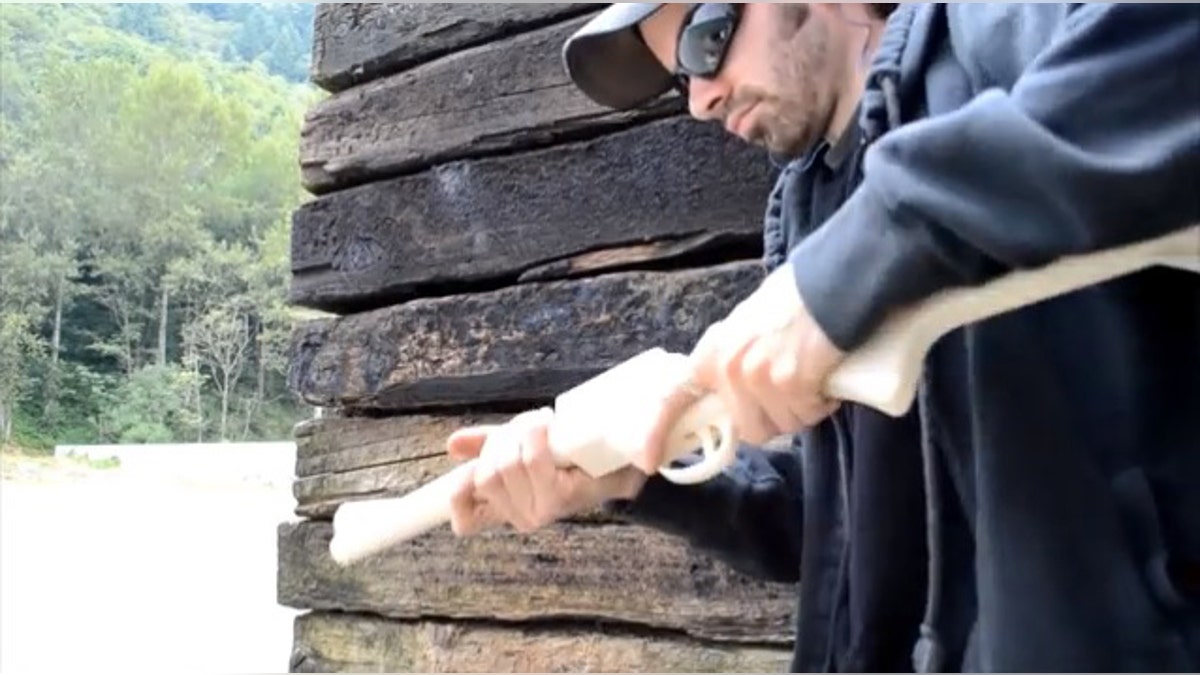
A man who would identify himself only as "Matthew" fires a homemade rifle he calls "The Grizzly 2.0" in a YouTube video. (YouTube)
Reports of a Canadian man successfully firing 14 single rounds from a rifle manufactured by a 3D printer has the weapon’s American designer wondering whether the apparent breakthrough will force the U.S. government to rethink its ban on posting his plans online.
While early models based on firearms designer Cody Wilson’s plans backfired or fired only once before breaking, the latest test appears to prove that homemade plastic guns are viable -- and that the Internet may have dramatically changed how we look at regulating the trade in arms.
“I’m expecting some interesting decisions from the State Department soon regarding the legal status of the disclosures of the plans,” Wilson told FoxNews.com Thursday.
Wilson and his company Defense Distributed released plans online last May for a rifle called “the Liberator,” which appeared strikingly similar to "The Grizzly 2.0" shown in a YouTube video being fired by a Canadian man. The State Department immediately ordered Wilson to take down his plans, citing national security.
“Defense Distributed was put on ice and threatened with massive penalties … if we didn’t stop doing what we’re doing. We’re private developers who shouldn’t have government interference,” Wilson said.
'We’re private developers who shouldn't have government interference.'
The State Department's Bureau of Political-Military Affairs told FoxNews.com on Thursday that it could not comment on whether there are ongoing compliance matters, but said there is essentially no change in status since May.
“Although we do not comment on whether we have individual ongoing compliance matters, we can confirm that the department has been in communication with the company,” the agency said at the time.
The office referred FoxNews.com to comments made by deputy spokesman Pat Ventrell last May, when the agency said that Defense Distributed’s posting of plans online were tantamount to unlicensed and unregulated arms distribution. Distribution of arms is regulated under ITAR (International Traffic in Arms Regulations) laws, and therefore a matter of national security.
“We view [enforcing regulations on handguns] as an integral part of safeguarding U.S. national security and furthering U.S. foreign policy objectives," Ventrell said in a press briefing. "The U.S. is cognizant of the potentially adverse consequences of indiscriminate arms transfers, and therefore we strictly regulate export of defense items and technologies to protect our national interest.”
"We can confirm that the Department has been in communication with the company.”
In the latest firing, a Canadian man printed out a rifle and claimed to fire 14 shots from it, using Winchester Dynapoint bullets. The single-shot rifle must be taken apart and reloaded after each firing, as seen in a YouTube video detailing the stunt.
The gun maker, a tinkerer who would only reveal his first name, Matthew, told The Verge he felt confident enough about the weapon to fire it by hand, rather than attaching a string to the trigger as he had in earlier tests.
"I was completely confident to hand fire, and will be taking it out again with a friend with a new barrel this week," he said in an email.
Matthew had access to a Stratasys Dimension 1200ES industrial 3D printer at his job, where he makes parts for the construction industry. The printers cost $10,000 or more, but low-cost consumer models sell for far less and have ushered a revolution in 3D printing.
Still, it’s no surprise that the gun was made in Canada rather than in the U.S., Wilson said.
“The United States drew a line in the sand,” he told FoxNews.com. The ability to print working guns at home is a dramatic change, but government laws haven’t yet been updated to reflect the new reality.
“The world doesn’t operate like that anymore … it’s sclerotic. And the further the state is able to impose its 21st century view of how the world will operate, the more things will lag behind.”




















